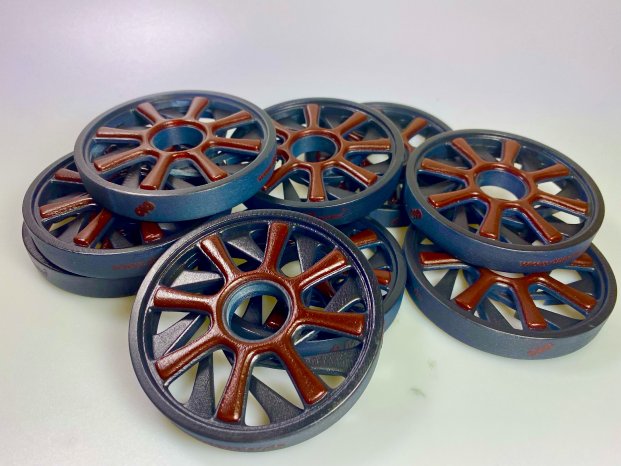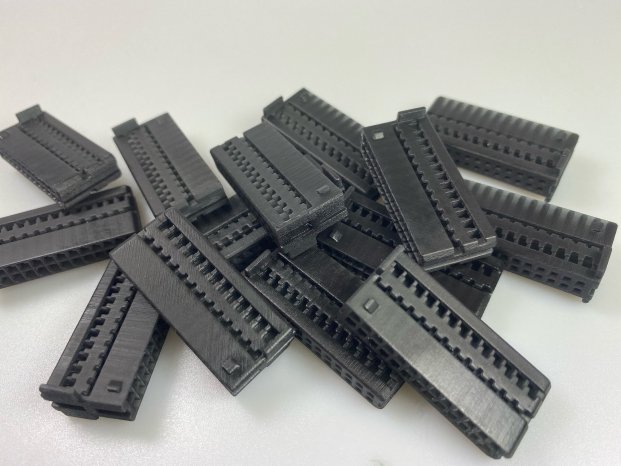- Outstanding precision: Industry-grade Cubic Ink® printing material families, including unprecedented heat resistance for manufacturer-independent use on 3D inkjet printers
- Multi–material capability for maximum productivity: A wide variety of printing materials can be processed using the continuous Multi–material Jetting process
- Three Cubic Ink® ink families: High Performance, Prototyping, and Support Materials
For the first time, a wide variety of materials, including engineering-grade materials with different properties and the support material can be printed in a continuous process. This multi-material capability increases productivity, reduces unit costs, and creates more flexibility in the industrial production of 3D printed objects.
“With Cubic Ink® we are setting new standards in additive manufacturing and, for the first time, opening up to industrial users an efficient and sustainable perspective for the series production of highly resilient components,” says Dr. Petra Severit, Chief Technology Officer of ALTANA AG.
“As a result, customers benefit directly from our core competence and decades of experience in the development of innovative resilient high-performance materials. After all, only with high-performance, application-specific materials can the technical potential of a disruptive technology like 3D printing be truly exploited.”
The three Cubic Ink® print material families at a glance:
1. High-Performance
- 1-series: Excellent strength and heat resistance up to 193 °C, ideal for applications with hot liquids such as in the engine compartment;
- 4-series: Good balance between heat deflection temperature of 100 °C and toughness with an elongation at break of up to 6% for maximum design freedom.
Three types of material:
- “Tough/Rigid” with very good dimensional stability for robust applications;
- “Flexible” with variable degrees of hardness, adjustable elasticity, and high sharpness of detail for flexible or stretchable component parts;
- “Clear” for optical components – high transparency and individually adaptable due to a variable refractive index.
“Standard” and "Fast-dissolving” support materials. These are water-soluble, environmentally friendly, and can be removed automatically in a water bath without chemical solvents.
With Cubic Ink® ALTANA is once again expanding the range of applications for pioneering solutions in the highly innovative field of 3D printing. ALTANA AG recently expanded its portfolio of 3D printing materials by acquiring the business of TLS Technik GmbH & Co Spezialpulver KG and the British company Aluminium Materials Technologies Ltd. (AMT). In the hardware segment, ALTANA had already acquired a stake in dp polar in 2017 and has since been working closely with the technology company based in Eggenstein-Leopoldshafen near Karlsruhe.
dp polar is the manufacturer of the Inkjet AMpolary® machine generation, the world’s first 3D printing system with a continuously rotating print platform. Unlike previous processes, it is not the print head that moves, but the platform on which the print is made. At this year's formnext, the company is presenting the AMpolar® i1, a new, more compact model with a build volume of up to 240 liters and a print platform of almost one square meter. This makes it possible to print layers between 4-25 µm, achieving an excellent resolution of up to 720 x 720 x 5,000 dpi. This new system supplements the AMpolar® i2 system presented at the last formnext with a build volume of about 700 liters. Even the more compact model has a larger build volume than previous printing systems available on the market in the material jetting sector. Components can thus be produced up to 20 times faster in larger numbers.
“Our 3D printers of the AMpolar® machine generation are expressly designed for ALTANA's Cubic Ink® materials and therefore allow for optimal results,” says Dr. Florian Löbermann, Managing Director of dp polar GmbH. “Combined with ALTANA's expertise in material development, our inkjet 3D printers are currently the most productive and efficient printing solutions on the market.”
The Cubic Ink® printing material families now presented for industrial production open up completely new possibilities in product manufacture, especially for users in the automotive and aerospace industries, but also for medical technology (including orthoses).
Cubic Ink® materials: technical data sheets and more on
www.altana.com/cubic-ink
About dp polar:
dp polar is a dynamic, fast-growing technology company from Germany that develops 3D printing systems for industrial series production for the automotive, medical technology, aerospace, mechanical engineering, and consumer goods industries. dp polar's state-of-the-art additive manufacturing (AM) solutions meet the requirements of mass production of components and systems, improve supply chain efficiency, and reduce total cost of ownership. As a reliable and innovative partner, dp polar is successful in the AM ecosystem.
www.dppolar.de



